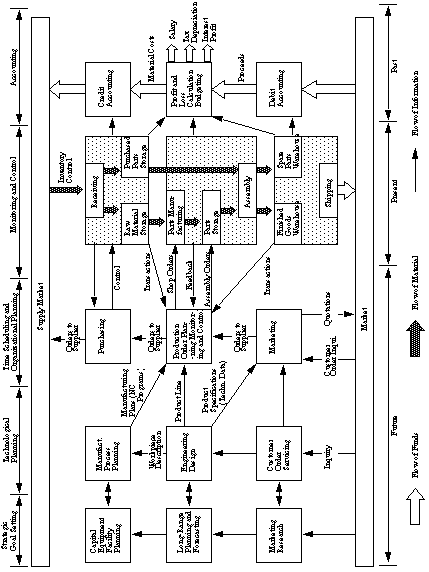1.1 WHY CAPP?New technologies can have a revolutionary impact upon the manufacturing state, as was seen during the Industrial Revolution. Computers are in the process of reshaping the modern industry. Manufacturers are rushing to apply this technology to remain competitive. To date a majority of the methods have been limited to enhancing and/or replacing existing manufacturing functions with software. Within the Manufacturing cycle, there are some fundamental functions (as shown in Figure 1.1 The Basic Manufacturing Cycle). The figure depicts one particular view of manufacturing suggested by Rembold et. al. [1985]. It is easy to see the complexity of the interactions between functions. Most of these functions have been automated for Accounting, Monitoring and Control, Time Scheduling and Organizational Planning. However, planning for all aspects of manufacturing has been very difficult to computerize because of its highly abstract and time variant nature. The systems that can do so are limited to very small domains. All of the systems for limited domains create a need for a system that will make higher level decisions between production technologies. In general terms, new product development is a function of; i) Design, ii) Process Planning, iii) Scheduling, iv) Control, and v) Manufacturing. The Design function has been supplemented with Computer Aided Design (CAD) and Computer Aided Engineering (CAE) tools that enable the modeling of geometry, analysis of stresses and 
(Adapted from Rembold et. al. [1985], pp.30) heat flow, evaluation of tooling, and other sophisticated problems to be defined. During process planning, the design is converted into a list of operations and resources that are required to direct production. Up to this point products and parts are dealt with individually. During scheduling, the process plans for a number of products are considered together as required by the customer orders. Finally, the Production Control function ensures that the schedules are being adhered to in a reasonable manner. The weakest link in the CIM (Computer Integrated Manufacturing) philosophy is Process Planning. The deficiencies of process planning have not resulted from a lack of effort by researchers. As early as 1965 the concept was discussed by Niebel [1965]. By 1988, Alting and Zhang [1988] listed 156 existing CAPP systems, of which 49 where alleged to be available commercially. Despite the large number of commercial packages, there are several reasons why CAPP systems have not been widely utilized to date: • Very limited process planning domains. • They require extensive setup. • Input is difficult, and often not from a common CAD package. One of the major hypotheses of this thesis is that the main reason for the shortcomings of process planning is a result of the method of product representation. This thesis aims to explore a new representation method which enhances the product representation using Boolean equations. The use of Boolean equations enables a new group of methods to be used to manipulate and analyze designs to eventually produce process plans. |